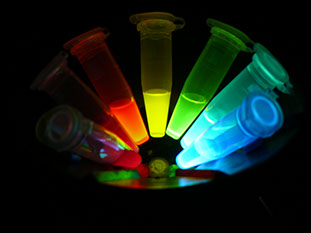Laboratory for Analytical Chemistry
Citterio Laboratory
Innovation of Chemical Sensors
Keio University
Faculty of Science and Technology
Department of Applied Chemistry

Fluorescent / Luminescent Functional Dyes
Fluorescent, chemiluminescent and bioluminescent organic functional dyes are widely used molecular tools in (bio)analytical chemistry. Our research work in this field is particularly focused on the development of dyes emitting light in response to pH or biological substances and on the extension of the available wavelength range into the near-infrared (NIR) region.
Near-infrared fluorescent Magnesium probe
The magnesium ion (Mg2+) is an essential cation for maintaining proper cellular activities. The problem with conventional Mg2+ responsive fluorescent probes is that they show high affinity not only for Mg2+ but also for Ca2+, and there are few color variations. Therefore, our group has developed the highly selective Mg2+ indicator KMG series based on the β-diketone moiety with fluorescence emission in the near infrared region (650 to 900 nm).
Bioluminescent dyes with enhanced optical properties
In order to expand the applicability of bioluminescent dyes, a D-luciferin derived from firefly has been directly linked to an allyl group, resulting in enhanced luminescence at longer wavelength compared to the parent compound.
Bioluminescent probe for thiol detection
There is a high demand for sensitive biothiol probes, because these biothiols play essential roles to maintain homeostasis and work as indicators of many diseases. In our group, biothiol-responsive bioluminescent probes have been developed by introducing protective groups that are selectively deprotected by biothiols into a bioluminescent substrate such as firefly luciferin D-luciferin and Renilla luciferin coelenterazine derivatives.
Other examples
Other developments of functional dyes include a variety of fluorophores responding to pH for chemical sensors and stable bioluminescent substrates for long-term imaging, among others.
For specific information, please refer to our list of publications.
Back
Citterio Laboratory 2023
Last update: February 16, 2023